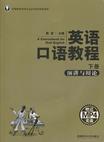英语口语教程
出版时间:1970-1 出版社:湖南师范大学出版社 作者:陈惠 编 页数:272
前言
《英语口语教程》分为上、下两册,旨在对学生进行循序渐进、全面系统的口语能力的训练。上、下册各有其侧重点,并相互衔接。上册“基本技能训练”侧重交际功能训练,从培养学生主动开口讲英语的热情和习惯开始,逐渐过渡到培养学生形成用英语思维的习惯,并学会用英语连贯表达。下册“演讲与辩论”主要是进行英语演讲和英语辩论的训练,使学生能比较系统、连贯地发表自己的见解,并展开争论,既锻炼学生的口语能力,也锻炼学生的思辨能力。 上册“基本技能训练”每单元包括“Warm-up”, “Listening,reading and acting”, “Further practice”和“Assignments”四部分。第一部分除了起到检查学生口语作业和调动课堂气氛的作用外,主要是从模仿入手,培养学生纯正的语音语调。本部分以音素、句子、段落、电影对白的模仿为主。第二部分继承了传统英语口语教学的精华——交际功能的训练,且课文主题与时代、学生生活、思想紧密相关,具有较强的时代感和实用性。第三部分将英语知识的学习和英语口语技能的操练交织在一起,操练的形式多种多样,有pair work,group work,picture-talking,story-retelling,discussion,story-making等,内容由浅入深,循序渐进;形式生动活泼,操作性极强。第四部分为学生提供了课后阅读和背诵材料,以增加学生在英、美文化和知识方面的积淀,从而提高学生英语口头表达的准确性和对文化差异的敏感性。 下册“演讲与辩论”包括演讲和辩论两大部分。演讲部分每单元体例与上册基本相同,由“Preliminary Tasks”,“Special Occasion Speeches”,“Guide to Public Speaking”和“Reading and Assignments”四部分组成。第一部分着重名人名篇片段的模仿,第二部分学习和训练特定场合的演讲,第三部分是即兴演讲的知识及技巧的学习和训练,第四部分是名人名篇的拓展阅读和深度讨论。辩论部分每单元基本上由“Warm up”、 “Guide to Debate”、“Debate Topic and Arguments”、 “Further Reading”和“Assignments”组成,旨在让学生熟悉一般英语辩论的过程和规则,培养学生的问题意识,提高学生知识的综合能力、批判性倾听能力、快速反应能力以及辨析能力。 本教材在理念上、内容上和形式上都有所创新。
内容概要
理念吸纳与采用“输出驱动假设”理论,强调输入与输出相结合;突破传统的英语口语教材进行单一口语教学的模式,将口语教学作为一个系统工程来进行立体建构。内容上册“基本技能训练”由18个单元组成,每个单元分为四大部分。第一部分热身训练,主要是从模仿入手,培养学生纯正的语音语调;第二部分情景对话,注重交际功能的训练,选材与社会发展、学生生活紧密相联;第三部分是与主题有关的拓展性课堂活动;第四部分为学生提供了课后阅读和背诵材料,以增加学生在英美文化和知识方面的积淀,从而提高英语口头表达语言的准确性和对文化差异的敏感性。下册由演讲与辩论两大部分组成。演讲部分将名人演讲和学生模仿训练相结合,将特殊情景下的演讲和普遍性演讲知识与技能学习相结合,使学生从模仿式的口语产出发展成积极的、创造性的、思辨性的口语产出;辩论部分旨在让学生熟悉一般英语辩论的过程和规则,培养学生的问题意识,提高学生的知识综合能力、批判性倾听能力、快速反应能力以及辨析能力。形式英语知识的学习和英语口语技能的操练交织在一起,有模仿表演、看图说话、故事复述、故事创作、角色演绎、主题演讲、专题辩论等,不同阶段的同类活动在难易程度上和形式上都有所变化。
书籍目录
Part I SpeechUnit 1Introduction SpeechesSection I Preliminary TasksSection II Special Occasion SpeechesSection III Guide to Public SpeakingSection IV Reading and AssignmentsUnit 2Welcome SpeechesSection I Preliminary TasksSection II Special Occasion SpeechesSection III Guide to Public SpeakingSection IV Reading and AssignmentsUnit 3Farewell SpeechesSection I Preliminary Tasks 020Section II Special Occasion SpeechesSection III Guide to Public SpeakingSection IV Reading and AssignmentsUnit 4Birthday Party SpeechesSection I Preliminary TasksSection II Special Occasion SpeechesSection III Guide to Public SpeakingSection IV Readin.q and AssignmentsUnit 5Wedding SpeechesSection I Preliminary TasksSection II Special Occasion SpeechesSection III Guide to Public SpeakingSection IV Reading and AssignmentsUnit 6Anniversary SpeechesSection I Preliminary TasksSection II Special Occasion SpeechesSection III Guide to Public SpeakingSection IV Reading and AssignmentsUnit 7Festival SpeechesSection I Preliminary TasksSection II Special Occasion SpeechesSection III Guide to Public SpeakingSection IV Reading and AssignmentsUnit 8Opening SpeechesSection I Preliminary TasksSection II Special Occasion SpeechesSection III Guide to Public SpeakingSection IV Reading and AssignmentsUnit 9Closing SpeechesSection I Preliminary TasksSection II Special Occasion SpeechesSection III Guide to Public SpeakingSection IV Reading and AssignmentsUnit 10Celebration SpeechesSection I Preliminary TasksSection II Special Occasion SpeechesSection III Guide to Public SpeakingSection IV Reading and AssignmentsUnit 11Award Presentation SpeechesSection I Preliminary TasksSection II Special Occasion SpeechesSection III Guide to Public SpeakingSection IV Reading and AssignmentsUnit 12Award Acceptance SpeechesSection I Preliminary TasksSection II Special Occasion SpeechesSection III Guide to Public SpeakingSection IV Reading and AssignmentsUnit 13Graduation SpeechesSection I Preliminary TasksSection II Special Occasion SpeechesSection III Guide to Public SpeakingSection IV Reading and AssignmentsUnit 14Thank-You SpeechesSection I Preliminary TasksSection II Special Occasion SpeechesSection III Guide to Public SpeakingSection IV Reading and AssignmentsUnit 15Promotion SpeechesSection I Preliminary Tasks L54Section II Special Occasion SpeechesSection III Guide to Public SpeakingSection IV Reading and AssignmentsUnit 16Memorial SpeechesSection I Preliminary TasksSection II Special Occasion SpeechesSection III Guide to Public SpeakingSection IV Reading and AssignmentsUnit 17ToastsSection I Preliminary TasksSection II Special Occasion SpeechesSection III Guide to Public SpeakingSection IV Reading and AssignmentsUnit 18Inaugural SpeechesSection I Preliminary TasksSection II Special Occasion SpeechesSection III Guide to Public SpeakingSection IV Reading and Assignments……Part Ⅱ Debate
章节摘录
Although much larger numbers of invertebrates are used and the use of flies and worms as model organisms is very important, experiments on invertebrates are largely unregulated and not included in statistics. Most animals are euthanized after being used in an experiment. Sources of laboratory animals vary between countries and species; while most animals are purpose-bred, others may be caught in the wild or supplied by dealers who obtain them from auctions and pounds. The research is conducted inside universities, medical schools, pharmaceutical companies, farms, defense establishments, and commercial facilities that provide animal-testing services to industry. It includes pure research such as genetics, developmental biology, behavioral studies, as well as applied research such as biomedical research, xenotransplantation, drug testing and toxicology tests, including cosmetics testing. Animals are also used for education, breeding, and defense research. The topic is highly controversial. Supporters of the practice, such as the British Royal Society, argue that virtually every medical achievement in the 20th century relied on the use of animals in some way, with the Institute for Laboratory Animal Research of the U.S. National Academy of Sciences arguing that even sophisticated computers are unable to model interactions between molecules, cells, tissues, organs, organisms, and the environment, making animal research necessary in some areas. ……
图书封面
评论、评分、阅读与下载
